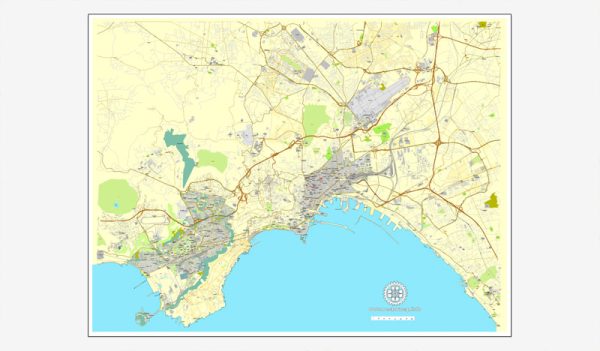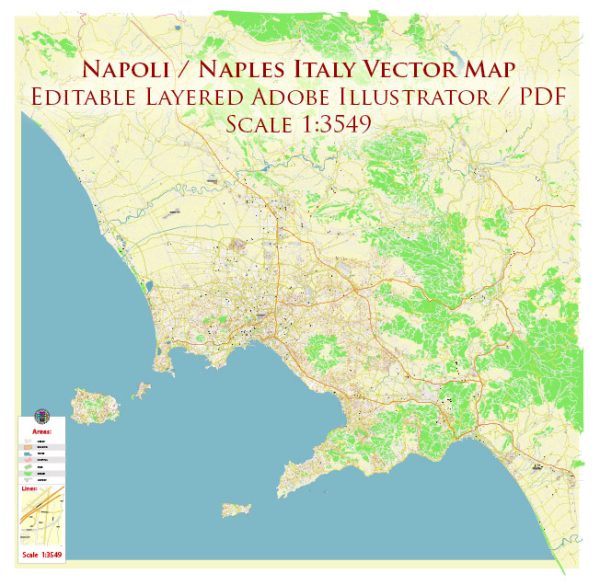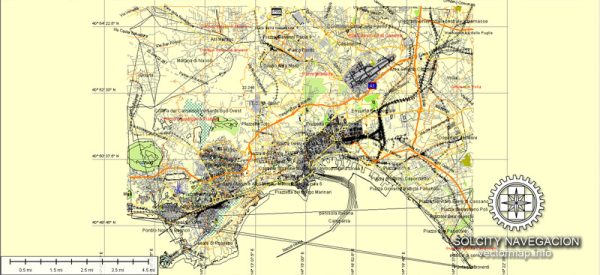Naples, Italy, is a city rich in history, culture, and urban vibrancy. As the capital of the Campania region and one of the oldest continuously inhabited cities in the world, Naples offers a unique blend of historical depth and modern life.
Vectormap.Net provide you with the most accurate and up-to-date vector maps in Adobe Illustrator, PDF and other formats, designed for editing and printing. Please read the vector map descriptions carefully.
Here’s a detailed description of the city’s history and its main streets:
History of Naples
Ancient Origins
- Foundation: Naples, known as Neapolis in ancient times, was founded by Greek settlers in the 8th century BC. The city’s name means “New City” in Greek, distinguishing it from the older part of the settlement, Palaeopolis (Old City).
- Roman Era: Naples became a significant cultural center during the Roman Empire. The city’s strategic location on the Bay of Naples made it a vital hub for commerce, trade, and cultural exchange. Naples retained its Greek language and customs longer than many other parts of Italy, contributing to its distinct identity.
Medieval Period
- Byzantine and Norman Rule: After the fall of the Roman Empire, Naples came under the control of the Byzantine Empire and later the Normans. The city maintained a degree of independence and became a duchy, with its own duke.
- Angevin and Aragonese Rule: In the 13th century, Naples was seized by the French Angevins, who made it the capital of the Kingdom of Naples. This period saw the construction of significant buildings, including the Castel Nuovo. Later, the city came under the control of the Spanish Aragonese dynasty, further enhancing its political and cultural importance.
Renaissance and Baroque Era
- Cultural Flourishing: Naples experienced a cultural renaissance during the 15th and 16th centuries, becoming a major center of art, music, and architecture. The city saw the construction of many of its iconic buildings, including palaces, churches, and fortifications.
- Spanish Rule: Naples remained under Spanish control for much of this period, which brought both wealth and social challenges. The city’s population grew rapidly, and it became one of the largest cities in Europe by the 17th century.
Modern History
- Napoleonic Wars and Unification of Italy: In the early 19th century, Naples was briefly under the control of Napoleon’s brother, Joseph Bonaparte, and later Joachim Murat. The city played a significant role in the Italian unification process, and in 1861, it became part of the newly unified Kingdom of Italy.
- World War II: Naples suffered extensive damage during World War II, particularly from Allied bombings. The city was also the site of a successful uprising against German occupation known as the Four Days of Naples in 1943, which led to its liberation.
- Post-War Period: In the post-war period, Naples faced challenges related to poverty, crime, and urbanization. However, the city also experienced a cultural revival and became a UNESCO World Heritage Site in 1995 due to its rich history and artistic heritage.
Main Streets of Naples
**1. Spaccanapoli
- Description: Spaccanapoli is one of the most famous streets in Naples, cutting straight through the historic center of the city. Its name means “Naples splitter,” as it divides the old town in half.
- Significance: This street is a living museum of the city’s history, lined with churches, palaces, and traditional shops. It represents the heart of Naples’ historic and cultural life.
- Key Landmarks:
- Church of Gesù Nuovo: A stunning Baroque church with a distinctive facade.
- Santa Chiara Monastery: A Gothic-style complex with a famous cloister decorated with colorful majolica tiles.
**2. Via Toledo
- Description: Via Toledo is one of Naples’ main shopping streets, running from Piazza Dante to Piazza Trieste e Trento near the Royal Palace.
- History: Originally known as Via Roma, the street was renamed to honor Pedro Álvarez de Toledo, the Spanish viceroy who ordered its construction in the 16th century.
- Significance: Via Toledo is a bustling commercial avenue, offering a mix of high-end stores, cafes, and historical buildings.
- Key Landmarks:
- Galleria Umberto I: A grand shopping arcade with a glass dome, reminiscent of Milan’s Galleria Vittorio Emanuele II.
- Piazza del Plebiscito: A large public square adjacent to the Royal Palace and the Basilica of San Francesco di Paola.
**3. **Via San Gregorio Armeno
- Description: This narrow street in the heart of the historic center is famous for its artisan workshops specializing in presepi (Nativity scenes).
- Significance: Via San Gregorio Armeno is a unique street where traditional crafts have been practiced for centuries. During the Christmas season, it becomes especially lively with visitors shopping for handmade Nativity figures.
- Key Landmarks:
- Church of San Gregorio Armeno: A Baroque church and convent, after which the street is named.
- Artisan Shops: Numerous small shops offering handcrafted items, particularly related to the Nativity.
**4. **Via dei Tribunali
- Description: Parallel to Spaccanapoli, Via dei Tribunali is another ancient street that runs through the heart of Naples.
- History: Originally part of the Greek and Roman road system (the decumanus), this street has been a central thoroughfare for centuries.
- Significance: Via dei Tribunali is known for its historic churches, pizzerias, and vibrant street life. It represents the lively, authentic spirit of Naples.
- Key Landmarks:
- Naples Cathedral (Duomo di San Gennaro): The city’s main cathedral, famous for the Miracle of San Gennaro.
- Church of San Lorenzo Maggiore: A Gothic church built over ancient Greco-Roman ruins.
**5. Chiaia District (Via Chiaia)
- Description: Via Chiaia is a stylish street located in the upscale Chiaia district, running from Piazza Trieste e Trento to Piazza dei Martiri.
- Significance: This street is known for its elegant boutiques, cafes, and historical buildings. It offers a more refined atmosphere compared to the bustling streets of the historic center.
- Key Landmarks:
- Piazza dei Martiri: A historic square surrounded by stately buildings and luxury shops.
- Palazzo Cellamare: A historic palace once owned by a powerful noble family.
**6. Corso Umberto I (Rettifilo)
- Description: Corso Umberto I, commonly known as Rettifilo, is a major thoroughfare that connects the central station area (Piazza Garibaldi) with the historic center.
- Significance: This street was part of the 19th-century urban renewal efforts, designed to modernize the city and connect key areas. Today, it’s a busy commercial street with a mix of shops, offices, and educational institutions.
- Key Landmarks:
- University of Naples Federico II: One of the oldest universities in the world, located along this street.
- Piazza Bovio: A key square near the port area, marking the transition from Corso Umberto I to the historic center.
Summary
Naples is a city with a deep and complex history, reflected in its vibrant streets and neighborhoods. From the ancient origins of Spaccanapoli and Via dei Tribunali, which cut through the heart of the historic center, to the elegant Via Chiaia and the bustling Via Toledo, each street tells a story of the city’s past and present. The city’s architectural and cultural landmarks, including its churches, palaces, and artisan shops, contribute to Naples’ rich urban tapestry, making it one of the most fascinating cities in the world.




 Author: Kirill Shrayber, Ph.D.
Author: Kirill Shrayber, Ph.D.